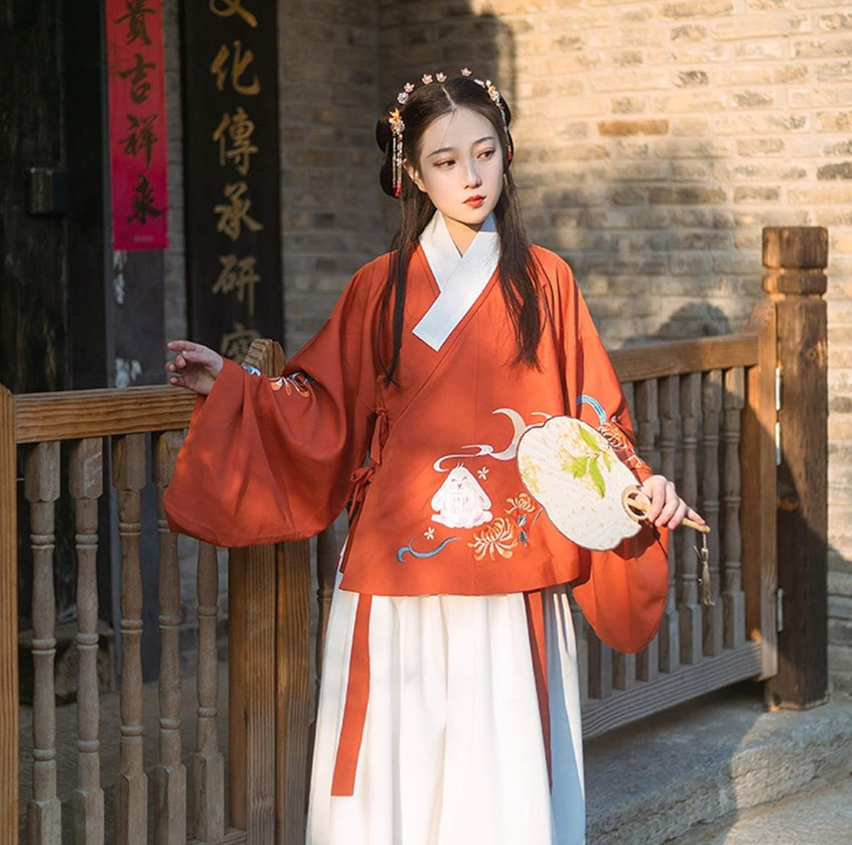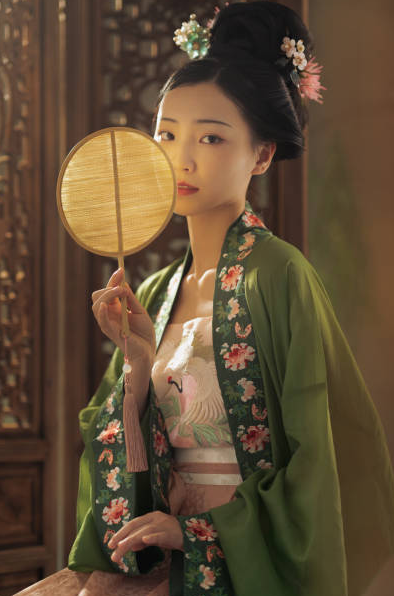Yes, royalty did wear Hanfu, with unique styles, materials, and embellishments denoting their royal status.
The Evolution of Hanfu
Early Developments and Variations
The Hanfu is an iconic representation of traditional Chinese clothing, its history tracing back over three millennia. Originating during the Han dynasty, the Hanfu showcases the aesthetic and cultural values of ancient China.
- Shenyi (深衣): Considered the most traditional form, the Shenyi is a robe that’s made of two pieces: a top and a skirt. These were usually made from silk, portraying the wearer’s elite status.
- Ruqun (襦裙): Predominantly worn by women, this attire consists of a blouse (Ru) and a wrap-around skirt (Qun). The varying lengths of the skirt often indicated the age or marital status of the wearer.
- Pifeng (披风): A type of overcoat, the Pifeng was generally worn to showcase one’s status. The intricate embroidery and design patterns were its hallmark.
For an in-depth understanding of these variations, visiting the Wikipedia page on Hanfu can provide a wealth of information.

Influence of Neighboring Cultures and Dynasties
China’s vast history and interactions with adjacent cultures played a significant role in shaping the Hanfu’s evolution.
- Tang Dynasty: The thriving international trade routes, especially the Silk Road, introduced new materials and designs. The Tang dynasty Hanfu became more varied, with wider sleeves and richer patterns.
- Mongol Influence during Yuan Dynasty: During the Yuan dynasty, when the Mongols ruled China, there was a noticeable blend of Mongol attire and Hanfu designs. This amalgamation led to the creation of Yuanlingshan, a new style of Hanfu.
- Manchu Influence during Qing Dynasty: The Manchurian-ruled Qing Dynasty brought forth significant changes. The Manchurian dress Qipao began to overshadow the traditional Hanfu. However, Hanfu’s essence remained integral to Chinese festivities and rituals.
Royalty and Hanfu
Distinctive Features of Royal Hanfu
Royal Hanfu has always stood out from its common counterparts due to the exclusivity of the designs, materials, and colors used. These costumes epitomized luxury, power, and the divine right of kingship.
- Materials: Royals predominantly wore silk, especially the rarer kinds like brocade (Jin) and gauze (Sha). The quality of the silk was superior, and the shine was more pronounced, giving it a regal appearance.
- Colors: Imperial yellow was reserved solely for the emperor, symbolizing the center of the universe. Similarly, phoenix and dragon motifs were exclusive to the royal family, representing femininity and masculinity, respectively.
- Accessories: Royals adorned themselves with intricate jewelry made from jade, gold, and pearls. Headpieces, like crowns and hats, had specific designs, often adorned with strings of pearls and precious stones.
For those keen on understanding the luxury of royal attire, the Wikipedia page on Chinese emperors provides fascinating insights.
Symbolism and Meaning Behind Royal Designs
Every design, motif, and color on the royal Hanfu was chosen with purpose and intent. They weren’t just aesthetically pleasing but were imbued with profound cultural and spiritual significance.
- Dragon and Phoenix: The dragon symbolized imperial power, while the phoenix represented peace and prosperity. When used together, they epitomized the perfect Yin and Yang balance.
- Five-clawed Dragon: Exclusively reserved for emperors, this motif distinguished the emperor from other royals and nobles, who were only allowed to wear robes with dragons that had fewer claws.
- Floral Designs: Flowers like peonies and lotuses were often embroidered on royal robes. While peonies symbolized wealth and honor, lotuses represented purity and enlightenment.
Hanfu Across Different Dynasties
Hanfu during the Qin and Han Dynasties
The Qin and Han dynasties laid the foundation for what is now recognized as Hanfu. The style of this period was relatively simplistic, but it marked the beginning of Hanfu’s rich journey.
- Qin Dynasty: In this foundational period, the Hanfu was mainly Shenyi, a one-piece robe that wrapped around the body. The higher-ranked officials and nobles wore darker colors, while commoners wore lighter shades.
- Han Dynasty: The Han era saw a proliferation in the types and styles of Hanfu. The cross-collared robe became popular. Silk, due to the flourishing Silk Road trade, became even more widespread in its use, leading to the creation of intricate Hanfu designs.
For more on the early Hanfu styles, the Wikipedia page on Han Dynasty is informative.
Tang Dynasty’s Take on Hanfu
The Tang Dynasty is often referred to as the golden age of Chinese culture, and this brilliance was reflected in the Hanfu of this era.
- Diverse Styles: With the influence of international trade, Hanfu styles became more varied. The round-necked robe and high-waisted skirt were notable introductions.
- Cosmopolitan Influence: Due to the cosmopolitan nature of the Tang capital, Chang’an, foreign designs and patterns found their way into Hanfu, making them more vibrant and diverse.
For a deeper dive into Tang’s fashion, the Wikipedia page on Tang Dynasty is a great resource.
Song, Yuan, Ming, and Qing Dynasties: Changes and Continuities
As dynasties changed, so did the Hanfu, reflecting the socio-political conditions and cultural influences of each era.
- Song Dynasty: The Hanfu became more slender and fitting, with designs such as the Beizi and the short jacket with long skirt becoming trendy.
- Yuan Dynasty: With the Mongol rule, the Hanfu incorporated some elements from Mongolian attire, although the essence of Hanfu remained unchanged.
- Ming Dynasty: Ming marked a return to Han traditions, and the Hanfu saw a revival of older styles with modifications, making them more ornate.
- Qing Dynasty: The Manchu rule introduced new garments like the Qipao, overshadowing the Hanfu. However, Hanfu still retained its symbolic importance in rituals and traditional festivities.
Material and Craftsmanship
Fabrics Used in Royal Hanfu
Royal Hanfu, as a symbol of regality and nobility, was crafted using the finest materials available. These fabrics were not just a showcase of wealth but also a reflection of the status of the wearer.
- Silk: Predominantly, the fabric of choice for the royals was silk, especially the fine and glossy types like satin and damask. Different types of silk, such as Jin (brocade) and Sha (gauze), had unique textures and were used for specific occasions.
- Gold-threaded Fabric: For the most grandiose events, fabrics interwoven with real gold threads were used. This made the Hanfu shimmer under light, adding an ethereal quality to it.
- Fur and Pelts: In colder regions, furs from animals like foxes and sables were integrated into Hanfu designs, showcasing both luxury and functionality.
For a deeper understanding of ancient Chinese textiles, the Wikipedia page on Chinese silk offers valuable insights.
Embroidery and Ornamentation Techniques
The beauty of royal Hanfu wasn’t just in its fabric but also in the intricate details that adorned it.
- Embroidery: Chinese embroidery is a revered craft. Royals favored the Su Xiu (Suzhou embroidery) style for its precision and intricacy. Designs often included mythological creatures, nature scenes, and symbols of luck and prosperity.
- Beading and Sequins: To add further opulence, beads, pearls, and sequins were often sewn onto royal Hanfu. This not only added aesthetic appeal but also increased the garment’s weight, giving it a more luxurious feel when worn.
- Painting: Some Hanfu were hand-painted with dyes extracted from plants and minerals. These paintings could be vast landscapes or detailed portraits, depending on the robe’s size.
Ceremonial Uses of Hanfu in Royalty
Rituals and Ceremonies Requiring Specific Hanfu
In the world of Chinese royalty, each event, ritual, and ceremony had its designated attire. These specific types of Hanfu served not just for aesthetic purposes but also as a medium to convey deeper meanings and intentions.
- Coronation Ceremonies: When an emperor ascended the throne, he would wear a specific type of Hanfu, usually adorned with the dragon motif and made of the finest silk. This symbolized his divine right to rule and his connection to the heavens.
- Ancestral Rituals: Paying respects to ancestors was a vital part of Chinese culture. For such events, royals wore Hanfu in somber colors, often adorned with symbols of longevity and respect.
- Marriage Ceremonies: Royal weddings were grand events, and the Hanfu for these occasions were made of red silk, symbolizing luck and joy. They were often embroidered with motifs of phoenixes and dragons, representing the union of yin and yang.
For further insights into traditional Chinese rituals and their importance, the Wikipedia page on Chinese rituals is enlightening.
Colors and Their Significance in Royal Events
Colors in royal Hanfu weren’t randomly chosen; they held deep symbolic meanings and played crucial roles in representing the intent of ceremonies.
- Yellow: Representing the center of the universe, imperial yellow was predominantly reserved for the emperor. It symbolized his role as the mediator between heaven and earth.
- Red: A color of luck, prosperity, and happiness, red was prominent in celebrations and joyous events like weddings.
- Black: Often associated with water, the north direction, and winter, black was considered a neutral color and was used in various ceremonies.
- White: In contrast to many cultures where white signifies purity, in ancient China, it was often associated with mourning and was worn during funerals and memorial services.

Contrast with Commoner Hanfu
Differences in Style, Material, and Embellishment
When contrasting royal Hanfu with those worn by the common people, distinct differences arise. While royal Hanfu emphasized opulence and symbolism, commoner Hanfu was more about functionality and affordability.
| Criteria | Royal Hanfu | Commoner Hanfu |
|---|---|---|
| Material | Luxurious silks, gold-threaded fabrics, and animal furs. | Common fabrics like cotton, linen, and rougher silks. |
| Style | Elaborate designs with longer robes, wider sleeves, and intricate collars. | Simplistic designs, narrower sleeves, and practical styles for daily activities. |
| Embellishment | Detailed embroidery with gold and silver threads, beading, and hand-paintings. | Minimal embroidery, often just simple patterns or stitches for reinforcement. |
| Colors | Bright and vibrant colors like imperial yellow, jade green, and deep red. | Neutral or muted colors like browns, grays, and off-whites. |
For a comprehensive understanding of the style variations across different social classes, the Wikipedia page on Hanfu provides a broad overview.
Access and Affordability for the General Population
The common population’s Hanfu primarily focused on durability, comfort, and affordability, differing significantly from the royals’ ornate and luxurious counterparts.
- Availability: While the royal Hanfu was custom-made by specialized artisans, commoner Hanfu was often homemade or purchased from local markets.
- Cost: Royal Hanfu, given its fine materials and craftsmanship, was expensive and beyond the reach of an average citizen. In contrast, commoner Hanfu, made of cheaper materials and with less ornamentation, was much more affordable.
- Durability Over Aesthetics: Commoners prioritized durability over aesthetics due to their work-intensive lifestyles. Their Hanfu was often thicker and sturdier, designed to withstand the rigors of everyday tasks.